Abstract
A three year old girl with severe watery diarrhoea and a vasoactive intestinal peptide, calcitonin, and catecholamine-secreting supra-renal ganglioneuroblastoma is reported. Steady-state perfusion studies showed the jejunum to be in a net secretory state with respect to water, sodium, and chloride at low concentrations (2 mmol/l) of glucose whereas higher concentrations (56 mmol/l) reversed secretion to absorption; transmural rectal potential difference was increased (lumen negative); Na+ absorption by the rectum was impaired and secretion of potassium and bicarbonate excessive. Motility studies showed prolonged, slowly propagated migrating motor complexes with abnormal runs of non-propagated contractions in the fasting state. During perfusion with glucose, no postprandial activity occurred. These results suggest that diarrhoea results from small intestinal secretion with impaired colonic function and that tumour products may have a direct effect on intestinal motility.
Full text
PDF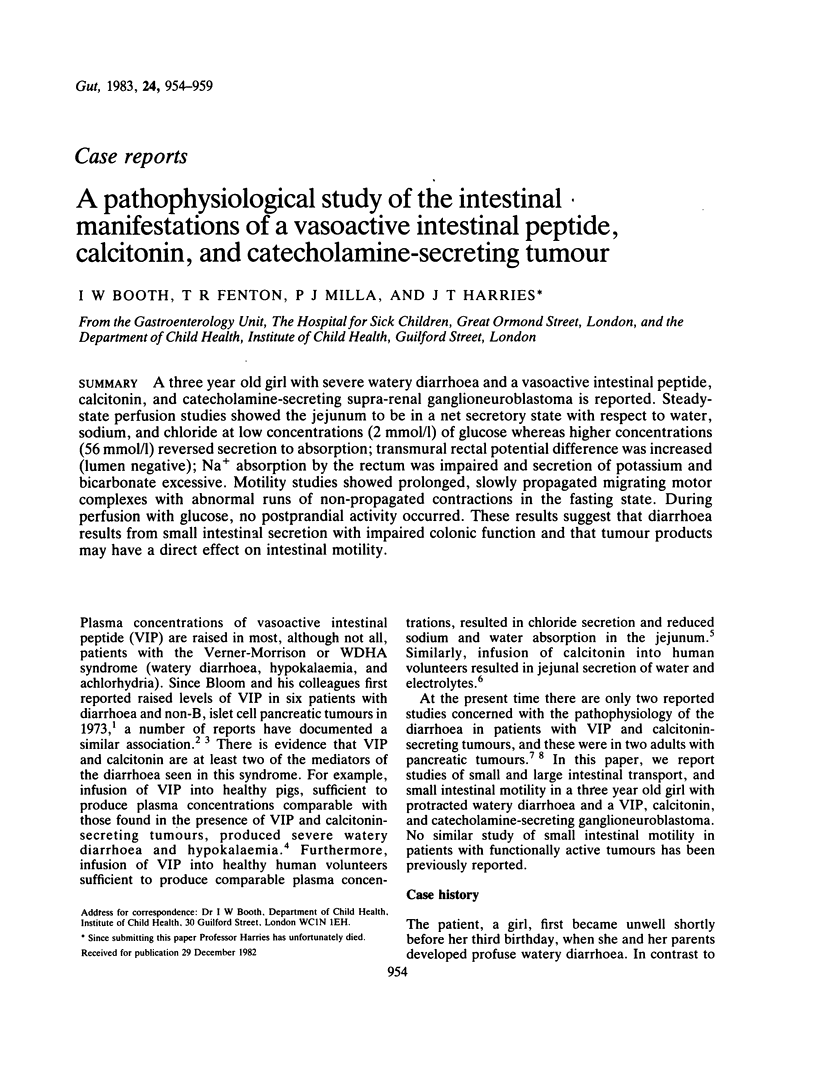
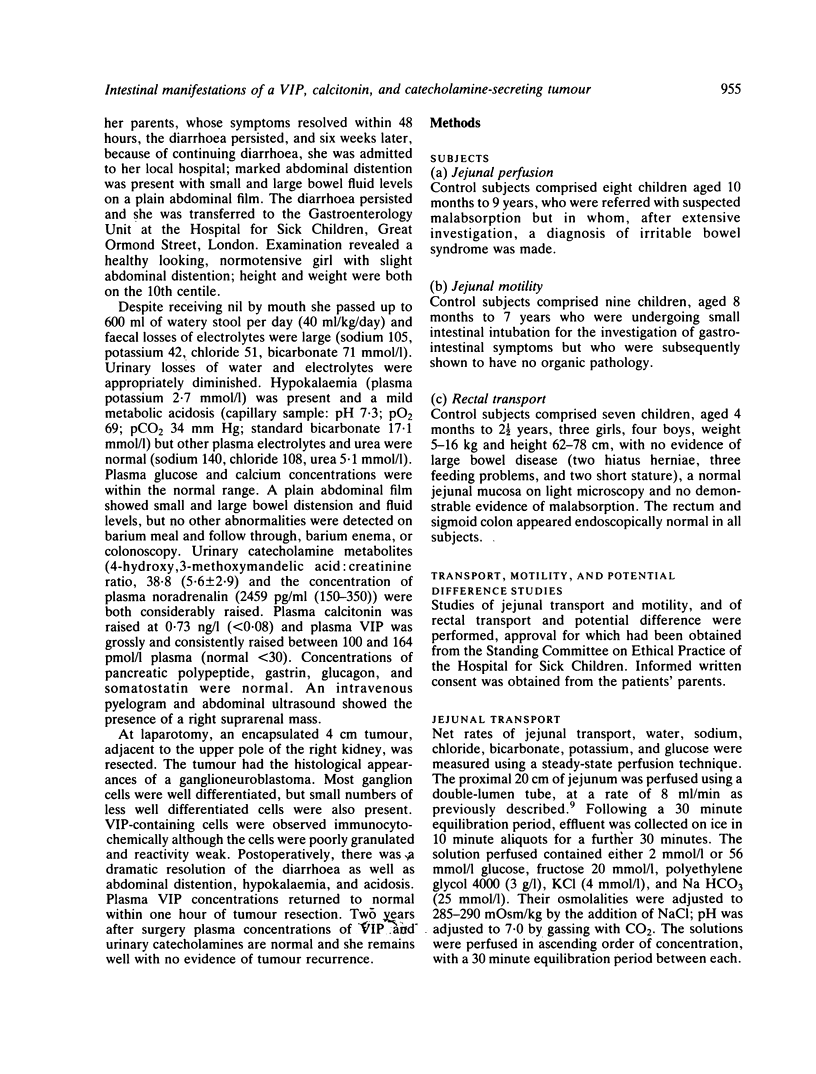

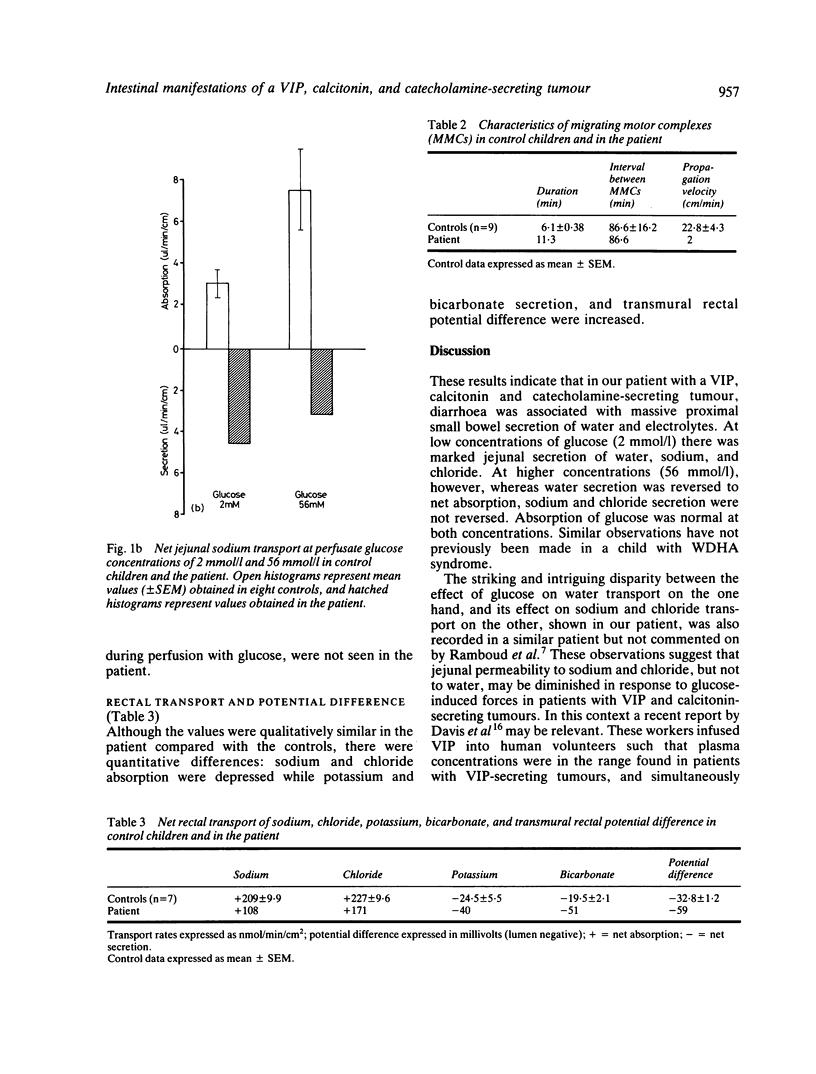
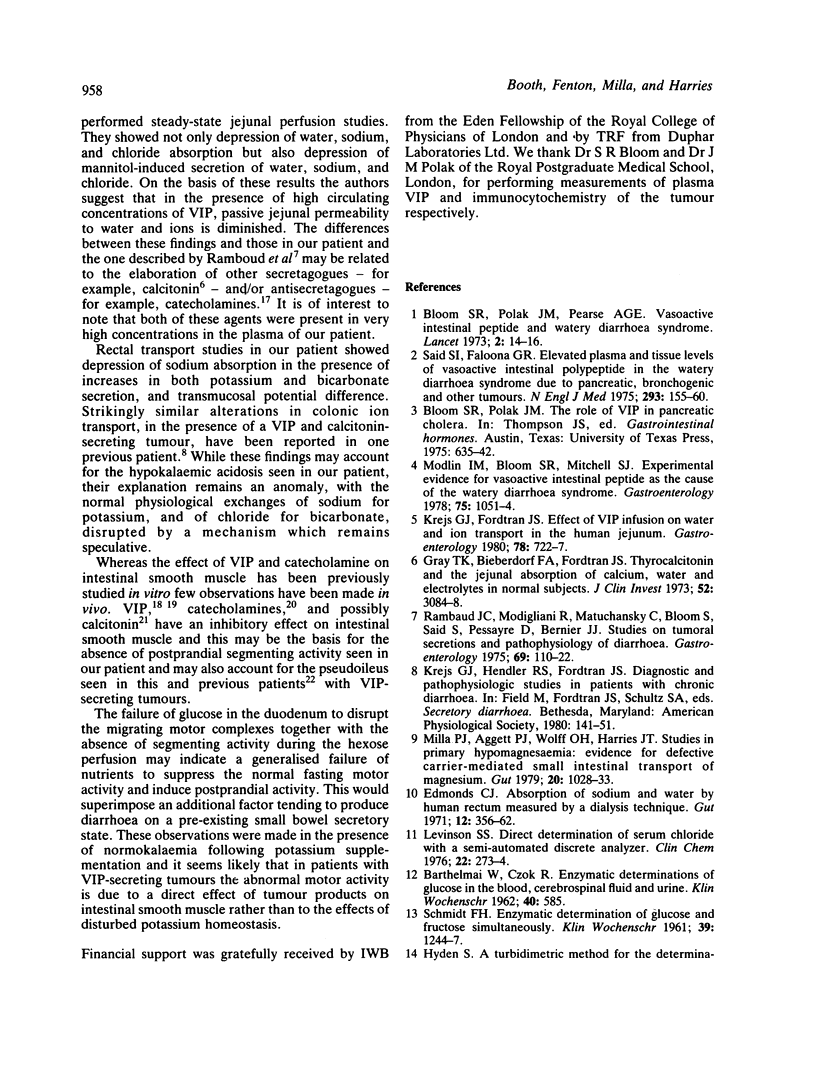
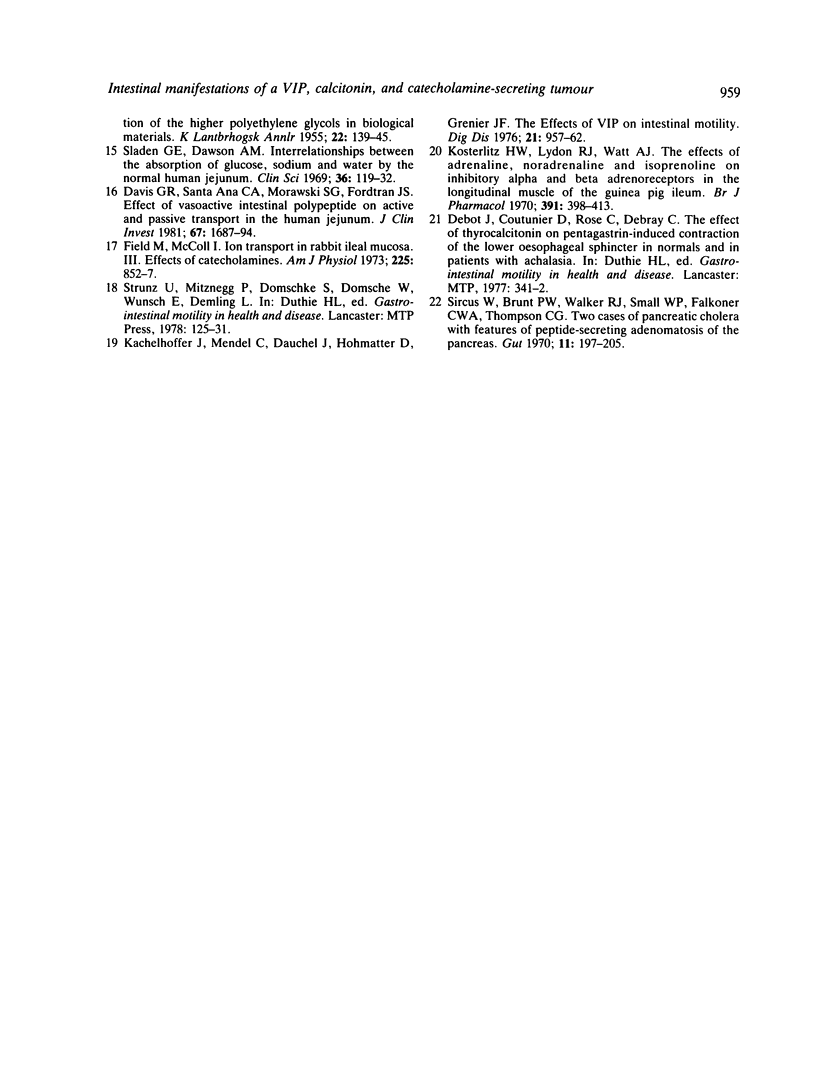
Selected References
These references are in PubMed. This may not be the complete list of references from this article.
- BARTHELMAI W., CZOK R. [Enzymatic determinations of glucose in the blood, cerebrospinal fluid and urine]. Klin Wochenschr. 1962 Jun 1;40:585–589. doi: 10.1007/BF01478633. [DOI] [PubMed] [Google Scholar]
- Bloom S. R., Polak J. M., Pearse A. G. Vasoactive intestinal peptide and watery-diarrhoea syndrome. Lancet. 1973 Jul 7;2(7819):14–16. doi: 10.1016/s0140-6736(73)91947-8. [DOI] [PubMed] [Google Scholar]
- Davis G. R., Santa Ana C. A., Morawski S. G., Fordtran J. S. Effect of vasoactive intestinal polypeptide on active and passive transport in the human jejunum. J Clin Invest. 1981 Jun;67(6):1687–1694. doi: 10.1172/JCI110206. [DOI] [PMC free article] [PubMed] [Google Scholar]
- Edmonds C. J. Absorption of sodium and water by human rectum measured by a dialysis method. Gut. 1971 May;12(5):356–362. doi: 10.1136/gut.12.5.356. [DOI] [PMC free article] [PubMed] [Google Scholar]
- Field M., McColl I. Ion transport in rabbit ileal mucosa. 3. Effects of catecholamines. Am J Physiol. 1973 Oct;225(4):852–857. doi: 10.1152/ajplegacy.1973.225.4.852. [DOI] [PubMed] [Google Scholar]
- Gray T. K., Bieberdorf F. A., Fordtran J. S. Thyrocalcitonin and the jejunal absorption of calcium, water, and electrolytes in normal subjects. J Clin Invest. 1973 Dec;52(12):3084–3088. doi: 10.1172/JCI107507. [DOI] [PMC free article] [PubMed] [Google Scholar]
- Kachelhoffer J., Mendel C., Dauchel J., Hohmatter D., Grenier J. F. The effects of VIP on intestinal motility: study on ex vivo perfused isolated canine jejunal loops. Am J Dig Dis. 1976 Nov;21(11):957–962. doi: 10.1007/BF01071907. [DOI] [PubMed] [Google Scholar]
- Kosterlitz H. W., Lydon R. J., Watt A. J. The effects of adrenaline, noradrenaline and isoprenaline on inhibitory alpha- and beta-adrenoceptors in the longitudinal muscle of the guinea-pig ileum. Br J Pharmacol. 1970 Jun;39(2):398–413. doi: 10.1111/j.1476-5381.1970.tb12903.x. [DOI] [PMC free article] [PubMed] [Google Scholar]
- Krejs G. J., Fordtran J. S., Fahrenkrug J., Schaffalitzky de Muckadell O. B., Fischer J. E., Humphrey C. S., O'Dorisio T. M., Said S. I., Walsh J. H., Shulkes A. A. Effect of VIP infusion in water and ion transport in the human jejunum. Gastroenterology. 1980 Apr;78(4):722–727. [PubMed] [Google Scholar]
- Levinson S. S. Direct determination of serum chloride with a semiautomated discrete analyzer. Clin Chem. 1976 Feb;22(2):273–274. [PubMed] [Google Scholar]
- Milla P. J., Aggett P. J., Wolff O. H., Harries J. T. Studies in primary hypomagnesaemia: evidence for defective carrier-mediated small intestinal transport of magnesium. Gut. 1979 Nov;20(11):1028–1033. doi: 10.1136/gut.20.11.1028. [DOI] [PMC free article] [PubMed] [Google Scholar]
- Modlin I. M., Bloom S. R., Mitchell S. J. Experimental evidence for vasoactive intestinal peptide as the cause of the watery diarrhea syndrome. Gastroenterology. 1978 Dec;75(6):1051–1054. [PubMed] [Google Scholar]
- Rambaud J. C., Modigliani R., Matuchansky C., Bloom S., Said S., Pessayre D., Bernier J. J. Pancreatic cholera. Sudies on tumoral secretions and pathophysiology of diarrhea. Gastroenterology. 1975 Jul;69(1):110–122. [PubMed] [Google Scholar]
- SCHMIDT F. H. [Enzymatic determination of glucose and fructose simultaneously]. Klin Wochenschr. 1961 Dec 1;39:1244–1247. doi: 10.1007/BF01506150. [DOI] [PubMed] [Google Scholar]
- Said S. I., Faloona G. R. Elevated plasma and tissue levels of vasoactive intestinal polypeptide in the watery-diarrhea syndrome due to pancreatic, bronchogenic and other tumors. N Engl J Med. 1975 Jul 24;293(4):155–160. doi: 10.1056/NEJM197507242930401. [DOI] [PubMed] [Google Scholar]
- Sircus W., Brunt P. W., Walker R. J., Small W. P., Falconer C. W., Thomson C. G. Two cases of "pancreatic cholera" with features of peptide-secreting adenomatosis of the pancreas. Gut. 1970 Mar;11(3):197–205. doi: 10.1136/gut.11.3.197. [DOI] [PMC free article] [PubMed] [Google Scholar]
- Sladen G. E., Dawson A. M. Interrelationships between the absorptions of glucose, sodium and water by the normal human jejunum. Clin Sci. 1969 Feb;36(1):119–132. [PubMed] [Google Scholar]


